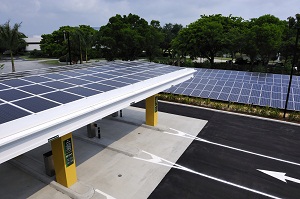Week in review: Heading into election season, looking to the sun
 With election season in underway in the U.S., candidates have been rather silent on renewable energy matters. That’s almost a surprise given the failure of Solyndra and the thousands of jobs renewable energy has created over the past few years. Meanwhile the European solar market remains the largest in the world, according to a new report. And another new report looks at the effectiveness of current tax-break-based incentives in the U.S. and how to improve them.
With election season in underway in the U.S., candidates have been rather silent on renewable energy matters. That’s almost a surprise given the failure of Solyndra and the thousands of jobs renewable energy has created over the past few years. Meanwhile the European solar market remains the largest in the world, according to a new report. And another new report looks at the effectiveness of current tax-break-based incentives in the U.S. and how to improve them.
First off, the U.S.’s National Solar Tour is getting under way again. For the last 17 years it’s been an opportunity for solar-powered homeowners across the U.S. to open their homes up to neighbors and show them how solar is making their lives better. This year, there’s an added bonus for participating, a sweepstakes with nearly $4,000 in prizes. So beyond learning more about how solar can make their lives and homes better, attendees may walk with something extra, like a $2,500 gift card to their favorite home improvement store.
Meanwhile, despite increased growth in the U.S. solar and renewables market, the European market remains the world’s largest for solar. That’s according to a new report from the European Commission. The report found that 70 percent of world’s photovoltaics were installed in Germany, Spain and Italy. In all, the European market consisted of more than 51 gigawatts of the more than 70 gigawatts of solar installed across the world. However, other markets, like the U.S. with a 40 percent year over year growth rate are growing at a faster rate than European markets.
Another report that came out last week looked at how effective incentive programs in the U.S. have been. While the Climate Policy Initiative’s report found that incentives have helped the solar and wind industries grow in the U.S., it found that incentive programs could be much more effective. The report found that by shifting to or using cash-based incentives rather than tax-based incentives, governments could save money and, at the same time, reduce costs for project developers.
In one of the more interesting developments in solar and electric vehicles (EVs), Tesla Motors unveiled the first six stations in its new Supercharger network. The network will allow owners of its Model S vehicles access to a network of free solar charging stations. First in California and Nevada and, as the network builds out, across the U.S. Owners of 85 kilowatt hour model and higher Model S will receive access to the chargers for free, Owners of its 60 kilowatt hour version will be able to use the chargers for a small fee. The chargers are capable of providing a full charge to the Model S in roughly an hour, according to Tesla.
Speaking of Solyndra, the U.S.’s Department of Energy, is coming close to issuing a loan guarantee to SoloPower. The program, which has helped many of the large solar projects in the U.S. get underway, was also the program that supported Solyndra. Now SoloPower is on target to receive dispersement of a loan guarantee as it starts producing photovoltaics at its new manufacturing plant in Oregon.
Hawaii is the U.S.’s most expensive electric market. It’s also the first market in the U.S. where solar is reaching grid-parity with other forms of electric generation. As such solar is really starting to take off in the island state. In response to the increasing popularity of solar Honolulu decided to take its permitting process online. The city decided that online solar permitting would help significantly reduce lines and the time waited at the city’s permitting office.



